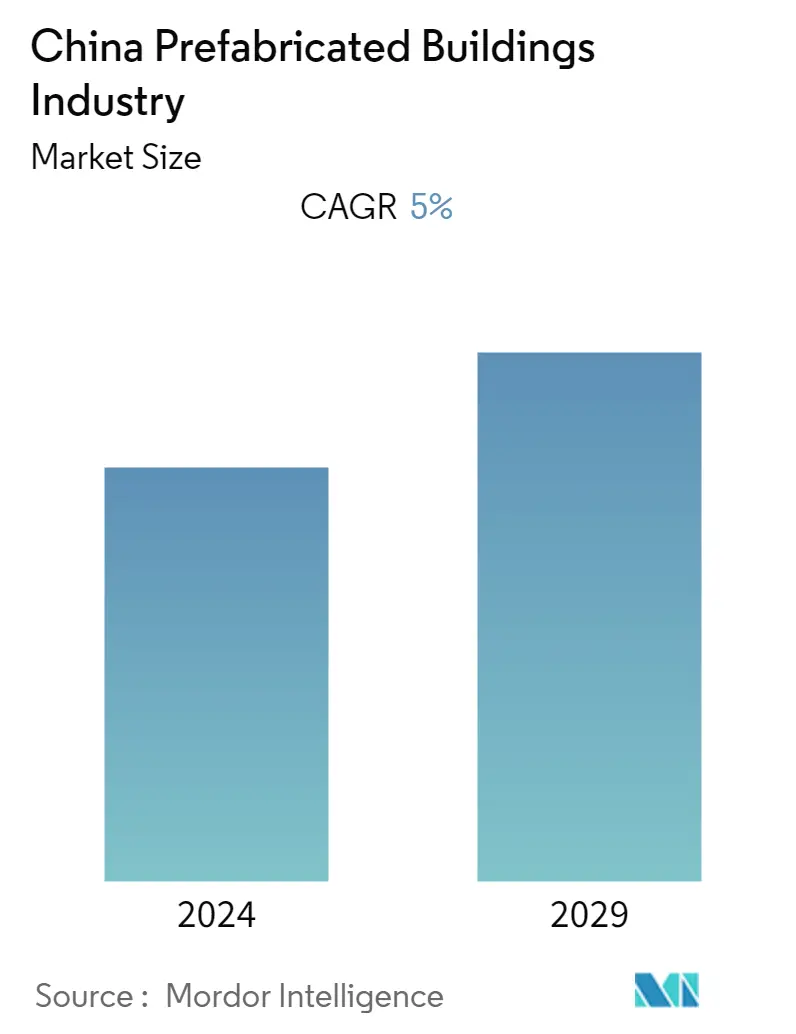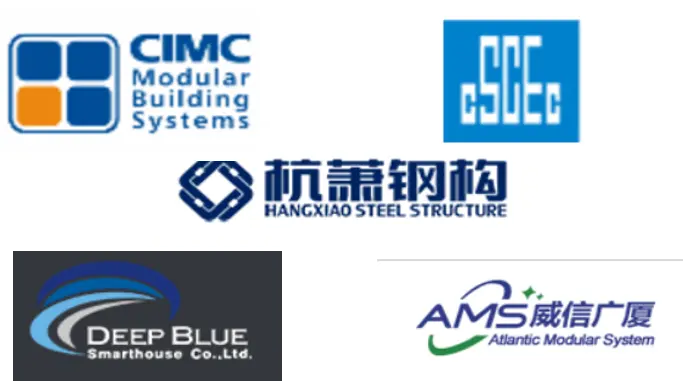Market Size of China Prefabricated Buildings Industry

| Study Period | 2020 - 2029 |
| Base Year For Estimation | 2023 |
| Forecast Data Period | 2024 - 2029 |
| Historical Data Period | 2020 - 2022 |
| CAGR | 5.00 % |
| Market Concentration | High |
Major Players
*Disclaimer: Major Players sorted in no particular order |
China Prefabricated Buildings Market Analysis
The Prefabricated Building Market in China is expected to grow at a CAGR of approximately 5% during the forecast period. Rising concerns over the green infrastructure and sustainable living to accommodate the needs of the increasing population will be the main driving factor.
The revenue generated from the prefabricated buildings industry in the year 2016 amounted to USD 37.716 billion. In the year 2018, the value rose to USD 41.4 billion. China's prefabricated market is expected to reach 698.2 billion in 2030.
In the past ten years, with the rapid development of the economy, the rising labor costs, the precision and quality of prefabricated components, the improvement of the construction technology and management level of assembly buildings, and the promotion of national policy factors, prefabricated buildings have gained momentum.
In its 13th Five-Year Plan, covering economic and social development from 2016 to 2020, in the cities with a permanent population of more than 3 million, the government planned for active promotion of prefabrication such that the share reaches around 15% and in other areas, the government plans to increase the share to 10%. As the concern on green buildings is increasing in China, the prefabricated construction methods are expected to gain momentum.
The government is planning to increase the proportion of prefabricated buildings in the new construction in three areas. The key promotion areas include the three major urban agglomerations of Beijing-Tianjin-Hebei, Yangtze River Delta and Pearl River Delta, where the country is looking to increase the share to around 20%.
Some of the factors that constrained the growth of the prefabrication buildings industry in China include high initial cost, high-cost pressure without appropriate economic scale effects, lack of regulations addressing prefabricated construction practices, and others. In the context of green construction in China, the prominence for prefabrication is increasing in the building construction sector in the nation.
China Prefabricated Buildings Industry Segmentation
The China Prefabricated Buildings Market covers the growing trends and projects in prefab building markets, like commercial construction, residential construction, industrial construction. The report also covers the industry along the type of material used, like concrete, timber, glass, metal, and other types. Along with the scope of the report also it analyses the key players and the competitive landscape in the China Prefabricated Buildings Market. The impact of COVID'19 has also been incorporated and considered during the study.
| Material Type | |
| Concrete | |
| Glass | |
| Metal | |
| Timber | |
| Other Material Types |
| Application | |
| Residential | |
| Commercial | |
| Other Applications ( Industrial, Institutional, and Infrastructure) |
China Prefabricated Buildings Industry Size Summary
The prefabricated buildings industry in China is poised for significant growth, driven by increasing emphasis on sustainable and green infrastructure to meet the demands of a growing population. The sector has gained traction over the past decade due to factors such as rising labor costs, advancements in construction technology, and supportive national policies. The Chinese government has actively promoted prefabrication through its Five-Year Plans, aiming to increase the share of prefabricated buildings in urban areas and key economic regions. This push is part of a broader strategy to enhance urban development while addressing environmental concerns. Despite challenges like high initial costs and regulatory gaps, the industry is expected to expand as the country continues to focus on industrialization and urbanization.
China's urban landscape is evolving with smarter construction processes, leading to a surge in demand for precast concrete elements. The market for precast construction is anticipated to grow substantially, supported by the establishment of numerous precast factories across the region. Economic factors such as low lending rates and favorable housing policies are expected to further stimulate market growth. The presence of special economic zones and relaxed foreign ownership regulations are likely to attract investments, bolstering the prefabricated buildings sector. The market is competitive, with key players like CIMC Modular Building Systems and others leading the charge. As government policies continue to promote green and fabricated buildings, the industry is set to strengthen, aligning with national development goals.
China Prefabricated Buildings Industry Market Size - Table of Contents
-
1. MARKET INSIGHTS
-
1.1 Current Market Scenario
-
1.2 Technological Trends
-
1.3 Insights on Supply Chain/Value Chain Analysis of the Prefabricated Buildings Industry
-
1.4 Brief on Different Structures Used in the Prefabricated Buildings Industry
-
1.5 Cost Structure Analysis of the Prefabricated Buildings Industry
-
1.6 Impact of COVID 19
-
-
2. MARKET SEGMENTATION
-
2.1 Material Type
-
2.1.1 Concrete
-
2.1.2 Glass
-
2.1.3 Metal
-
2.1.4 Timber
-
2.1.5 Other Material Types
-
-
2.2 Application
-
2.2.1 Residential
-
2.2.2 Commercial
-
2.2.3 Other Applications ( Industrial, Institutional, and Infrastructure)
-
-
China Prefabricated Buildings Industry Market Size FAQs
What is the current China Prefabricated Buildings Market size?
The China Prefabricated Buildings Market is projected to register a CAGR of 5% during the forecast period (2024-2029)
Who are the key players in China Prefabricated Buildings Market?
CIMC Modular Building Systems, Hangxiao Steel Structure, China Construction Integrated Construction , Ningbo Deepblue Smart House and Atlantic Modular System are the major companies operating in the China Prefabricated Buildings Market.

